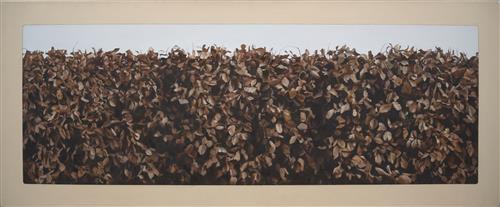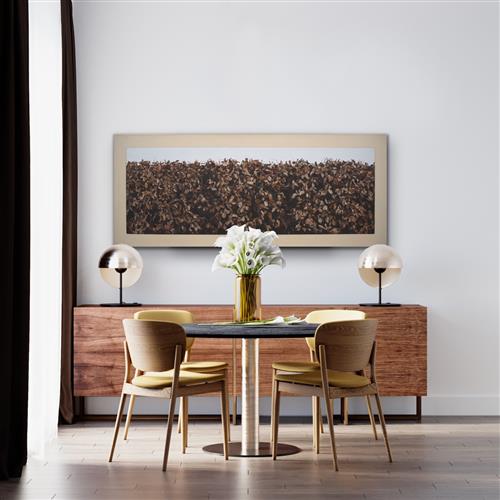Lot 86
A Hedge 1974
synthetic polymer paint on canvas
signed, dated and inscribed verso: W Delafield Cook/ Berlin 1974
82.5 x 199.5cm
Estimate $40,000 - $60,000
Please contact us directly for a condition report on this lot.
The opinions expressed in the condition reports are a guide only and should not be treated as a statement of fact. Prospective buyers are encouraged to physically inspect item, or book a virtual viewing or request further images during our pre-sale period where Leonard Joel staff are available for advice.
Please note condition reports can be amended during the pre-sale period, so we strongly suggest any interested bidders check the published condition report available on the website before the auction commences. Leonard Joel makes no guarantee of the originality of mechanical or applied components. Absence of reference to such modifications does not imply that a lot is free from modifications.
The National Australia Bank Art Collection
The Seventies: Australian Paintings and Tapestries From the Collection of National Australia Bank, National Gallery of Victoria, Melbourne, 15 October - 28 November 1982
The Seventies: A Selection of Australian Paintings and Tapestries From the Collection of National Australia Bank, Waverly City Gallery, Melbourne, 21 February - 13 March 1986, cat. no. 12
Lindsay, R. (ed.), The Seventies: Australian Paintings and Tapestries From the Collection of National Australia Bank, The National Bank of Australasia, Melbourne, 1982, p. 38 (illus.)
Hart, D. William Delafield Cook, Craftsman House in association with G+B Arts International, 1998, p. 105 (illus.)
"This painting contrasts with his earlier images of hedges and topiaries in formal garden settings. It reveals the shift...in the close-up concentration on a particular aspect of nature, removed from the surrounding context, and in the intricate handling of multiple, densely interwoven components - in this case of the coppery-coloured leaves"
(excerpt, p.105)
For most Australians, William Delafield Cook seemed to materialise fully-formed onto the local art scene - from nothing to the top of the tree overnight. The reasons for this were understandable, for his first exhibitions were held at the Redfern Gallery in London, a privilege earned after a decade teaching in English art schools and spending many hours contemplating the works in the great galleries of Europe. Born in the Melbourne suburb of Caulfield, he trained at the nearby Caulfield Technical College and then at the Royal Melbourne Institute of Technology. He left Australia in 1958 at the age of just 22, like many of his peers going 'OS' to broaden his horizons but, unlike most, he stayed on, making London his home base for the next 50 years. Like Sidney Nolan and Arthur Boyd before him, he spent the greater part of his working life resident in the United Kingdom, and like them he is always considered an 'Australian artist'.
After working through various forms of abstraction, Delafield Cook moved to a form of realism based wholly on photography. Australian art lovers had been shocked into the present, or at least the immediate past, when the NGV mounted the massive exhibition Two Decades of American Painting in 1967, which featured amongst the dominant abstract expressionists the huge photorealist paintings of James Rosenquist, creations based on the illustrations from popular magazines. While accurate realism had long been an aspiration among conservative artists, the idea of 'painting a photograph' was something entirely different. While many artists had freely incorporated photographic reference, it was only ever intended as a means to an end, not an end in itself. What William Delafield Cook took from the American pop artists was not the subject matter, but the obvious reliance on the photographic image and the cinematic scale. That he would rely on photographs was a given - he was after all painting the Australian landscape in the confines of his studio in Putney, half a world away. When his works did arrive in Australia, collectors and galleries alike were mesmerised by his strangely still and meticulously rendered paintings of haystacks and roadside vistas. We are all used to holding a postcard sized photograph and taking in the captured moments of family and friends, holiday snaps and foreign parts. What we see in that concentrated moment takes on a wholly different meaning when rendered on a huge scale, but with the same detail. Delafield Cook's paintings, when seen from a distance, appear as huge 'enlargements', like projections from a cinema or a photographic installation. But when approached, the details remain, rather than blurring out as would happen with a huge photograph. Even on the closest inspection the artist has not resorted to sleight of hand tricks - as we see in his haystacks, every blade of grass has been meticulously rendered, haystacks at the opposite end of the artistic spectrum to those of Claude Monet, for whom the stack was simply a large geometric form, textured and reflective at a moment in time.
When Australia did get to see the works of the mature Delafield Cook, he did not have to fight for acceptance, to work through the ranks like most of his peers. It is instructive to note that all our major institutions purchased his works within a year of their completion. The bulk of his paintings went to corporate collections and a small number of wealthy individuals - for not only were the prices daunting, the scale of the paintings made them ideal for public galleries and the foyers of corporate headquarters, way beyond the confines of most domestic spaces.
The subject work, A Hedge, has all the detail and meticulously rendered surface of the haystacks and hillsides, but our focus has been brought down to a few metres as we gaze at the dense foliage of the copper beech. The 'horizon' formed by the top of the hedge sits just below the top of the composition, enclosing and trapping us with no clue as to where we are - is it the artist's back garden, or some random wall in a local park? Just as the painting is flawless, so too is the hedge - not one weed, flower, bud or foreign plant intrudes upon the space. We search across the surface, looking for some small variation - perhaps the glimpse of a bird or spider web to break the pattern. The sky too is flat and featureless, as it always is with the Delafield Cook landscape. The cinematic feel is accentuated by the proportion of the work being 2.4:1, almost identical to the 2.35:1 of Cinemascope, 'wide screen' as best understood when the work was created. That effect is further accentuated by the broad painted frame with its rounded corners, a photographic device the artist often used to enclose his subjects and further separate them from the wider world. In every way the painting is an understated masterwork, with subtle and sophisticated colour and a quiet mystery of subject matter, which turns us in on ourselves as we contemplate the patience and dedication of a true artist.
Gavin Fry
Important Works from the NAB Art Collection
AUCTION
Sale: LJ8563
6:00pm - 23 February 2022
333 Malvern Rd, South Yarra 3141
VIEWING
Friday 18 February, 10am - 7pm
Saturday 19 - Sunday 20 February, 10am - 4pm
Monday 21 - Tuesday 22 February, by appointment
333 Malvern Road, South Yarra VIC
CONTACT
Summer Masters
nab.art@leonardjoel.com.au
SIMILAR ITEMS
Lot 66
HAROLD SEPTIMUS POWER (1878-1951) The Bullock Team c.1914 oil on canvas laid on board
Estimate: $70,000-90,000
Lot 38
RAY CROOKE (1922-2015) Boundary Rider, Palmer River Country, North Queensland c.1970 oil on canvas laid on board
Estimate: $30,000-50,000
Lot 25
MIRKA MORA (1928-2018) Curlews in the Garden 1980 wool, cotton and lurex tapestry
Estimate: $35,000-45,000
Lot 46
HUGH SAWREY (1923-1999) A Confidential Moment in the Bar of the Cattle Camp Hotel, Charleville, Queensland oil on board
Estimate: $35,000-45,000


